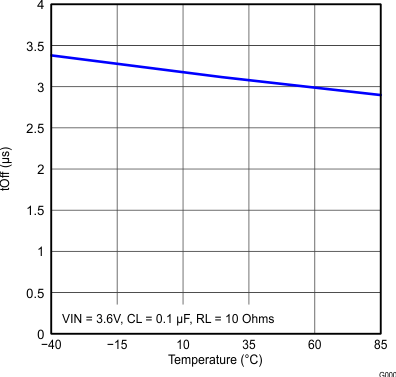SLVSAY8D June 2011 – January 2016 TPS22920
PRODUCTION DATA.
- 1 Features
- 2 Applications
- 3 Description
- 4 Revision History
- 5 Device Comparison Table
- 6 Pin Configuration and Functions
-
7 Specifications
- 7.1 Absolute Maximum Ratings
- 7.2 ESD Ratings
- 7.3 Recommended Operating Conditions
- 7.4 Thermal Information
- 7.5 Electrical Characteristics
- 7.6 Switching Characteristics: VIN = 3.6 V
- 7.7 Switching Characteristics: VIN = 0.9 V
- 7.8 Typical DC Characteristics
- 7.9 TPS22920 Typical AC Characteristics
- 7.10 TPS22920L Typical AC Characteristics
- 8 Parametric Measurement Information
- 9 Detailed Description
- 10Application and Implementation
- 11Power Supply Recommendations
- 12Layout
- 13Device and Documentation Support
- 14Mechanical, Packaging, and Orderable Information
7 Specifications
7.1 Absolute Maximum Ratings(1)
| MIN | MAX | UNIT | |||
|---|---|---|---|---|---|
| VIN | Input voltage range | –0.3 | 4 | V | |
| VOUT | Output voltage range | VIN + 0.3 | V | ||
| VON | Input voltage range | –0.3 | 4 | V | |
| IMAX | Maximum Continuous Switch Current | 4 | A | ||
| IPLS | Maximum Pulsed Switch Current, pulse <300 µS, 2% duty cycle | 6 | A | ||
| TJ | Maximum junction temperature | 125 | °C | ||
| Tstg | Storage temperature range | –65 | 150 | °C | |
(1) Stresses beyond those listed under Absolute Maximum Ratings may cause permanent damage to the device. These are stress only, and functional operation of the device at these or any other conditions beyond those indicated under Recommended Operating Conditions is not implied. Exposure to absolute-maximum-rated conditions for extended periods may affect device reliability.
7.2 ESD Ratings
| VALUE | UNIT | |||
|---|---|---|---|---|
| V(ESD) | Electrostatic discharge | Human-body model (HBM), per ANSI/ESDA/JEDEC JS-001(1) | ±4000 | V |
| Charged-device model (CDM), per JEDEC specification JESD22-C101(2) | ±1000 | |||
(1) JEDEC document JEP155 states that 500-V HBM allows safe manufacturing with a standard ESD control process. Manufacturing with less than 500-V HBM is possible with the necessary precautions.
(2) JEDEC document JEP157 states that 250-V CDM allows safe manufacturing with a standard ESD control process. Manufacturing with less than 250-V CDM is possible with the necessary precautions.
7.3 Recommended Operating Conditions
| MIN | MAX | UNIT | |||
|---|---|---|---|---|---|
| VIN | Input voltage range | 0.75 | 3.6 | V | |
| VOUT | Output voltage range | VIN | V | ||
| VIH | High-level input voltage, ON | VIN = 2.5 V to 3.6 V | 1.2 | 3.6 | V |
| VIN = 0.75 V to 2.49 V | 0.9 | 3.6 | V | ||
| VIL | Low-level input voltage, ON | VIN = 2.5 V to 3.6 V | 0.6 | V | |
| VIN = 0.75 V to 2.49 V | 0.4 | V | |||
| TA | Operating free-air temperature range | –40 | 85 | °C | |
| CIN | Input Capacitor | 1(1) | µF | ||
(1) See Input Capacitor section in Application Information.
7.4 Thermal Information
| THERMAL METRIC(1) | TPS22920x | UNIT | |
|---|---|---|---|
| YZP | |||
| 8 PINS | |||
| RθJA | Junction-to-ambient thermal resistance | 130 | °C/W |
| RθJC(top) | Junction-to-case (top) thermal resistance | 54 | |
| RθJB | Junction-to-board thermal resistance | 51 | |
| ψJT | Junction-to-top characterization parameter | 1 | |
| ψJB | Junction-to-board characterization parameter | 50 | |
(1) For more information about traditional and new thermal metrics, see the IC Package Thermal Metrics application report, SPRA953.
7.5 Electrical Characteristics
Unless otherwise noted, VIN = 0.75 V to 3.6 V| PARAMETER | TEST CONDITIONS | TA | MIN | TYP(1) | MAX | UNIT | ||
|---|---|---|---|---|---|---|---|---|
| IIN | Quiescent Current | IOUT = 0, Switch enabled | VIN = 3.6 V | Full | 68 | 160 | µA | |
| VIN = 2.5 V | 40 | 70 | ||||||
| VIN = 1.8 V | 25 | 350 | µA | |||||
| VIN = 1.2 V | 103 | 200 | ||||||
| VIN = 1.05 V | 78 | 110 | µA | |||||
| VIN = 0.75 V | 37 | 70 | ||||||
| IIN(leak) | Off Supply Current (After Pull Down) | Switch disabled, VOUT = 0 | Full | 5.5 | µA | |||
| rON | On-Resistance | VIN = 3.6 V, IOUT = –200 mA | 25°C | 5.3 | 8.8 | mΩ | ||
| Full | 9.8 | |||||||
| VIN = 2.5 V, IOUT = –200 mA | 25°C | 5.4 | 8.9 | mΩ | ||||
| Full | 9.9 | |||||||
| VIN = 1.8 V, IOUT = –200 mA | 25°C | 5.5 | 9.1 | mΩ | ||||
| Full | 10.1 | |||||||
| VIN = 1.2 V, IOUT = –200 mA | 25°C | 5.8 | 9.4 | mΩ | ||||
| Full | 10.4 | |||||||
| VIN = 1.05 V, IOUT = –200 mA | 25°C | 6.1 | 9.7 | mΩ | ||||
| Full | 10.8 | |||||||
| VIN = 0.75 V, IOUT = –200 mA | 25°C | 7.3 | 11.0 | mΩ | ||||
| Full | 12.4 | |||||||
| RPD | Output pull down resistance(2) | VIN = 3.3 V, Switch disabled, IOUT = 3 mA | Full | 1250 | 1500 | Ω | ||
| ION | ON input leakage current | VON = 0.9 V to 3.6 V or GND | Full | 0.1 | µA | |||
(1) Typical values are at VIN = 3.3 V and TA = 25°C.
(2) See Output Pull-Down .
7.6 Switching Characteristics: VIN = 3.6 V
TA = 25°C (unless otherwise noted)| PARAMETER | TEST CONDITION | TPS22920 | TPS22920L | UNIT | |
|---|---|---|---|---|---|
| TYP | TYP | ||||
| tON | Turn-ON time | RL = 10 Ω, CL = 0.1 µF, VIN = 3.6 V | 970 | 663 | µs |
| tOFF | Turn-OFF time | RL = 10 Ω, CL = 0.1 µF, VIN = 3.6 V | 3 | 2 | |
| tr | VOUT Rise time | RL = 10 Ω, CL = 0.1 µF, VIN = 3.6 V | 880 | 627 | |
| tf | VOUT Fall time | RL = 10 Ω, CL = 0.1 µF, VIN = 3.6 V | 2 | 2 | |
7.7 Switching Characteristics: VIN = 0.9 V
TA = 25°C (unless otherwise noted)| PARAMETER | TEST CONDITION | TPS22920 | TPS22920L | UNIT | |
|---|---|---|---|---|---|
| TYP | TYP | ||||
| tON | Turn-ON time | RL = 10 Ω, CL = 0.1 µF, VIN = 0.9 V | 840 | 840 | µs |
| tOFF | Turn-OFF time | RL = 10 Ω, CL = 0.1 µF, VIN = 0.9 V | 16 | 16 | |
| tr | VOUT Rise time | RL = 10 Ω, CL = 0.1 µF, VIN = 0.9 V | 470 | 470 | |
| tf | VOUT Fall time | RL = 10 Ω, CL = 0.1 µF, VIN = 0.9 V | 5 | 5 | |
7.8 Typical DC Characteristics
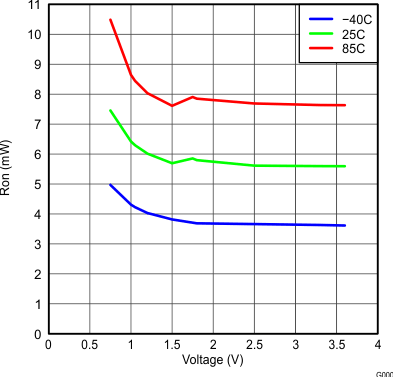
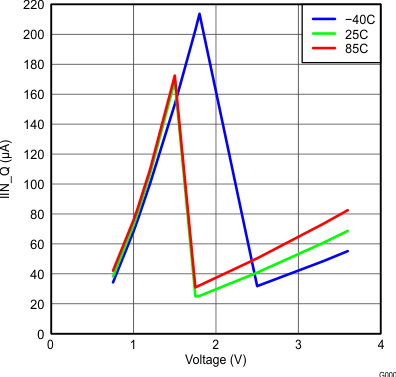
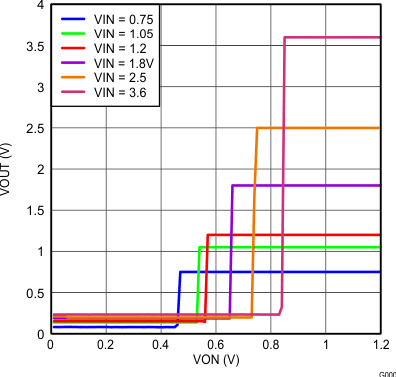
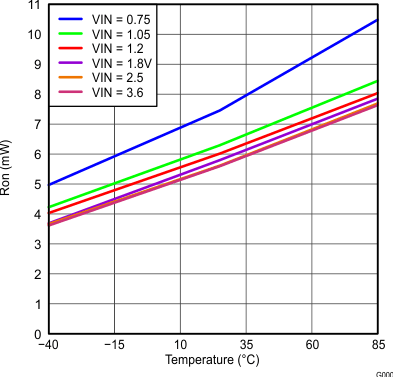
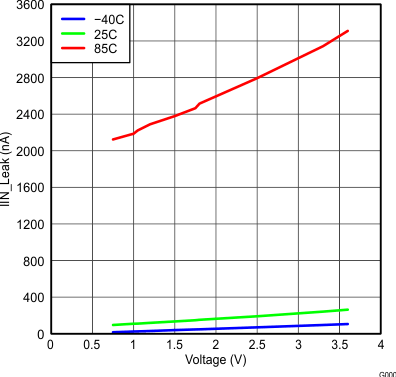
7.9 TPS22920 Typical AC Characteristics
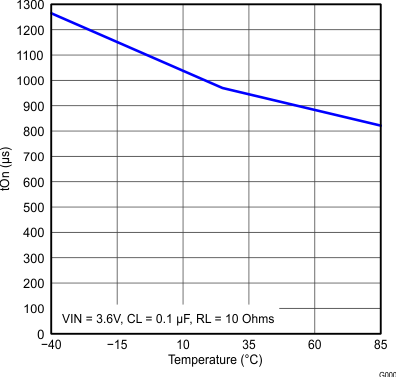
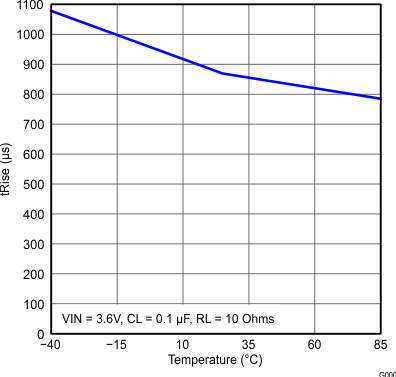
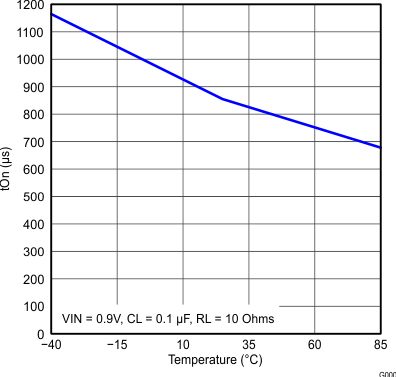
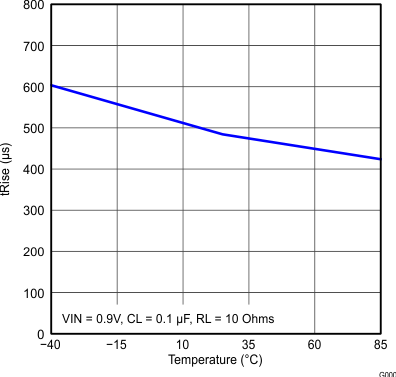
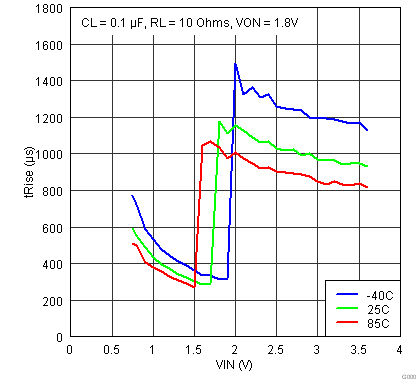
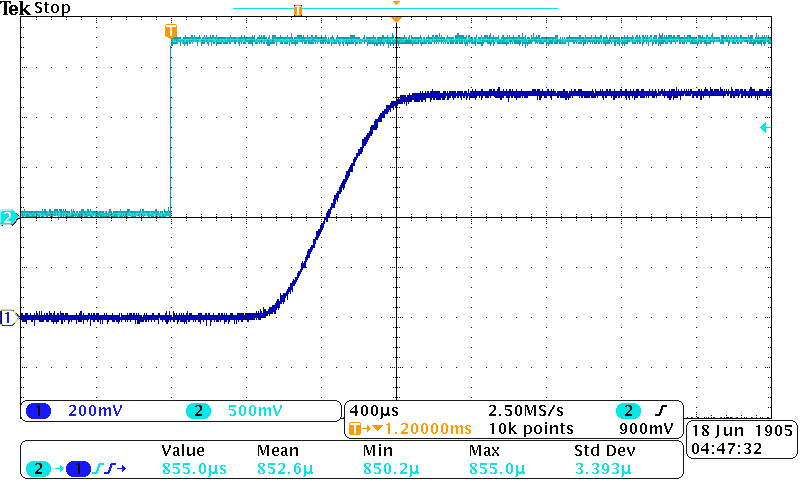
| VIN = 0.9 V | CIN = 1 µF | RL = 10 Ω |
| TA = 25°C | CL = 0.1 µF |
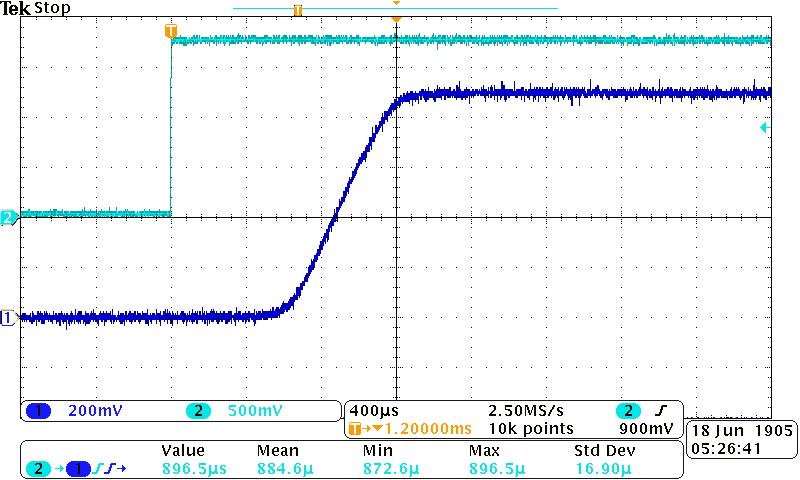
| VIN = 0.9 V | CIN = 47 µF | RL = 10 Ω |
| TA = 25°C | CL = 20 µF |
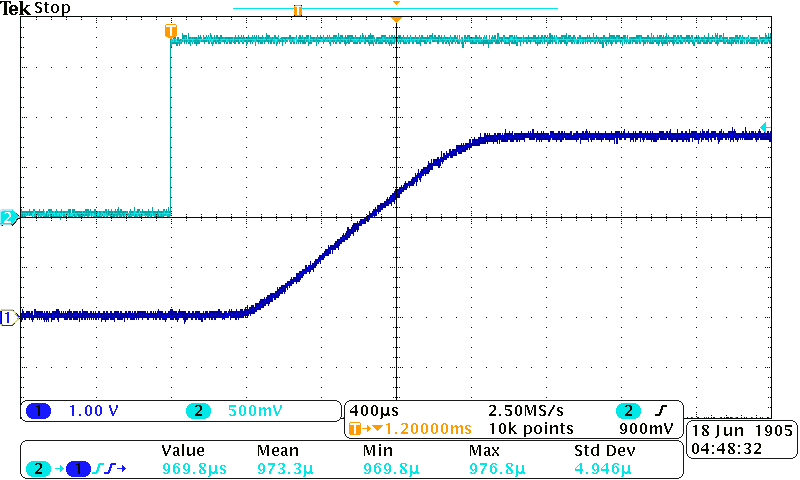
| VIN = 3.6V | CIN = 1 µF | RL = 10 Ω |
| TA = 25°C | CL = 0.1 µF |
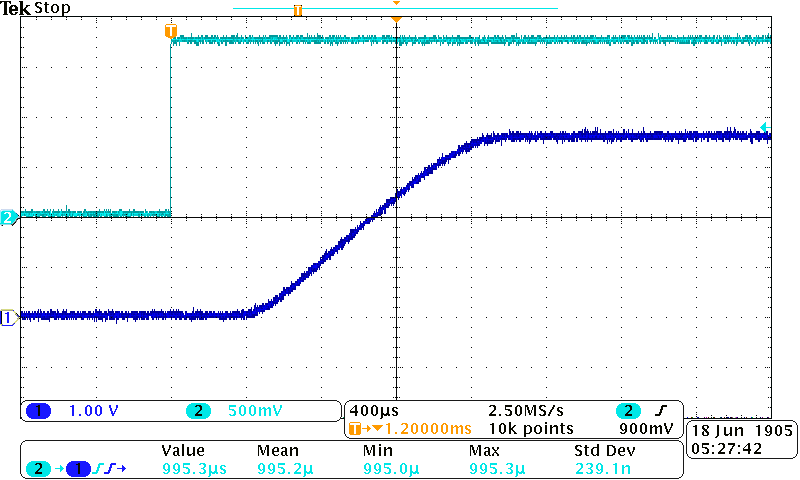
| VIN = 3.6 V | CIN = 47 µF | RL = 10 Ω |
| TA = 25°C | CL = 20 µF |
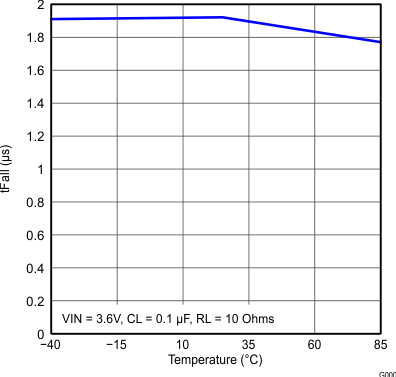
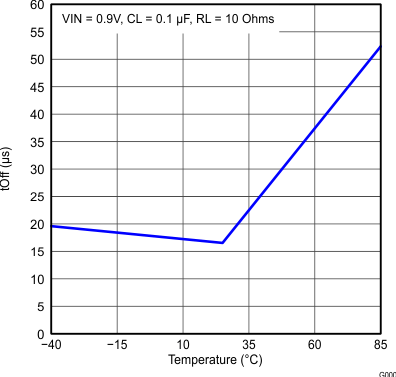
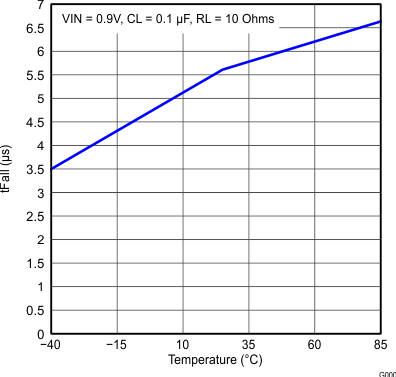
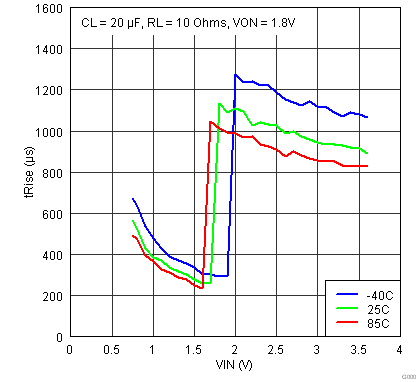
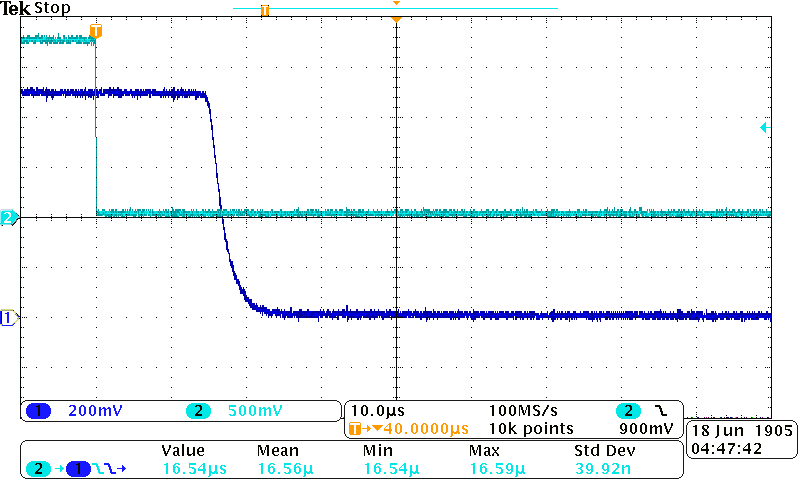
| VIN = 0.9 V | CIN = 1 µF | RL = 10 Ω |
| TA = 25°C | CL = 0.1 µF |
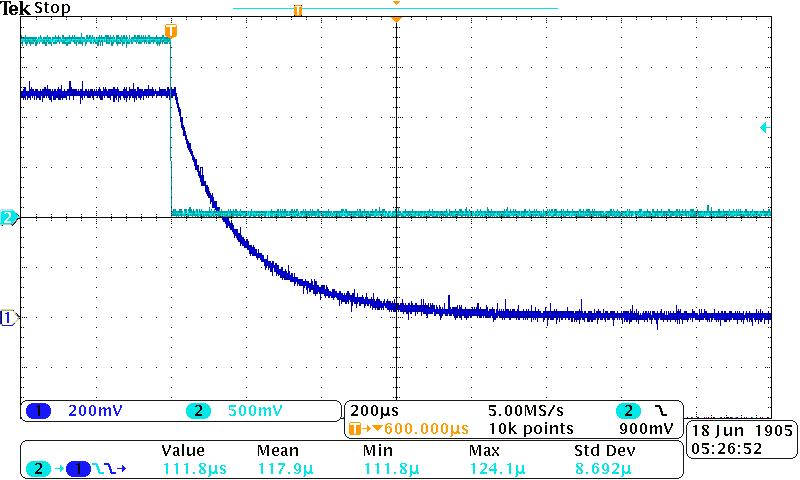
| VIN = 0.9 V | CIN = 47µF | RL = 10 Ω |
| TA = 25°C | CL = 20 µF |
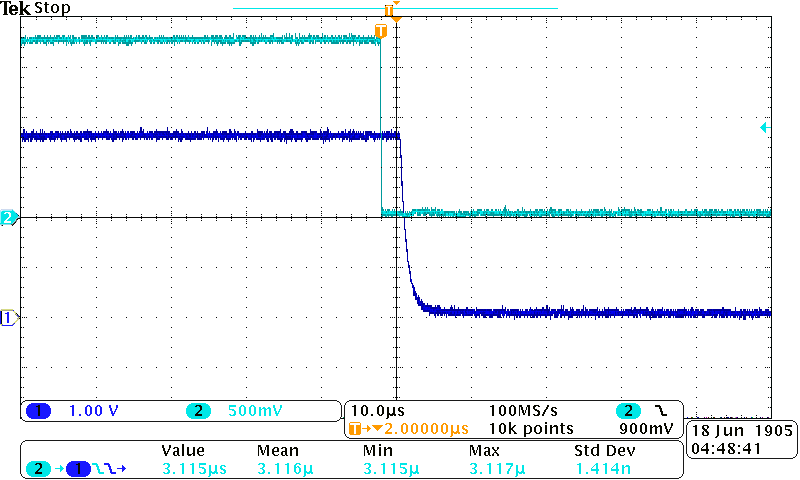
| VIN = 3.6 V | CIN = 1 µF | RL = 10 Ω |
| TA = 25°C | CL = 0.1 µF |
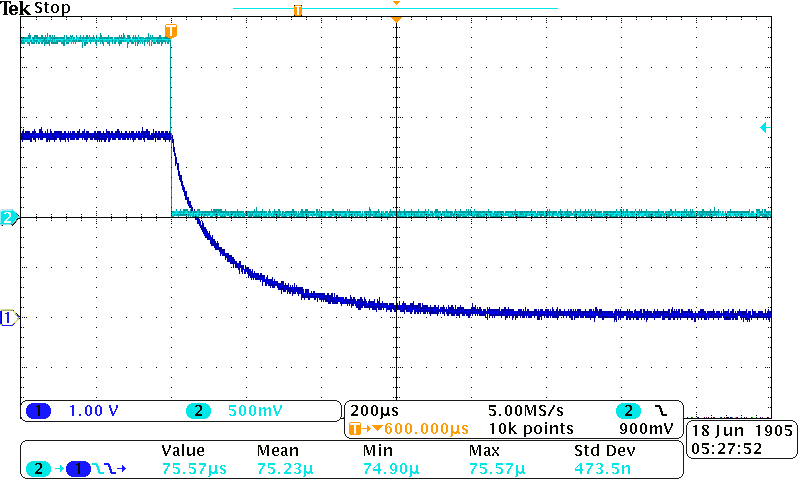
| VIN = 3.6 V | CIN = 47 µF | RL = 10 Ω |
| TA = 25°C | CL = 20 µF |
7.10 TPS22920L Typical AC Characteristics
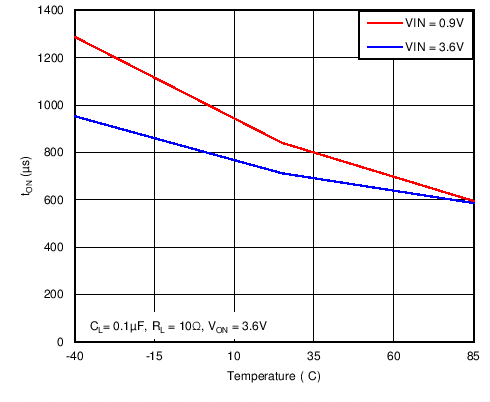
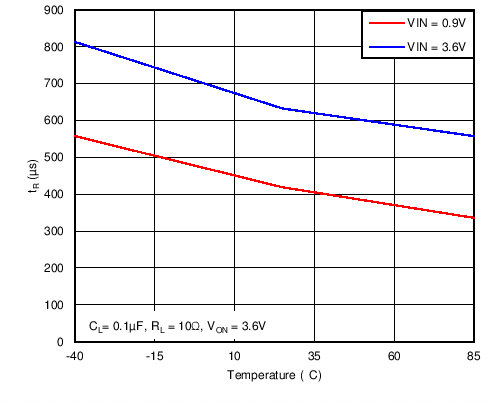
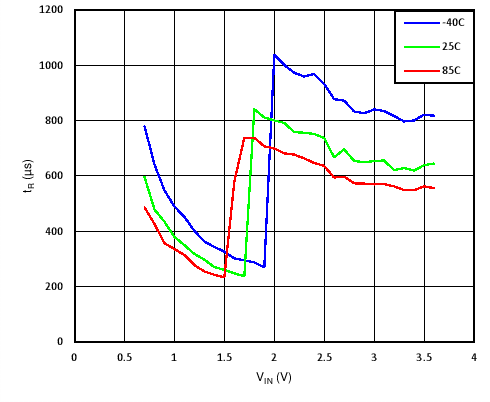
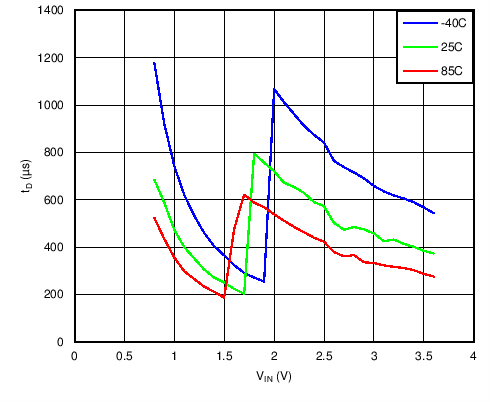
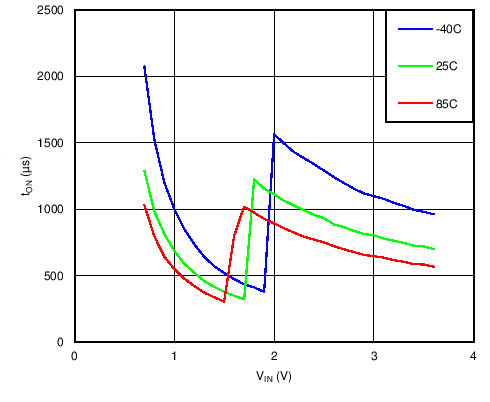
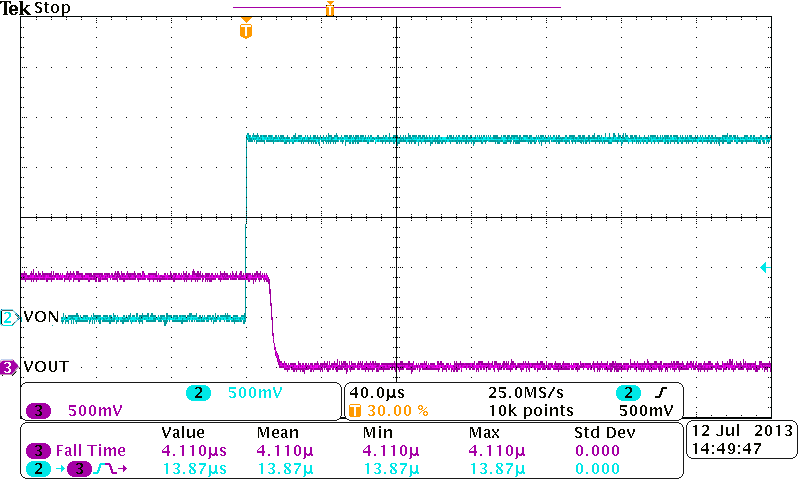
| VIN = 0.9 V | CIN = 1 µF | RL = 10 Ω |
| TA = 25°C | CL = 0.1 µF |
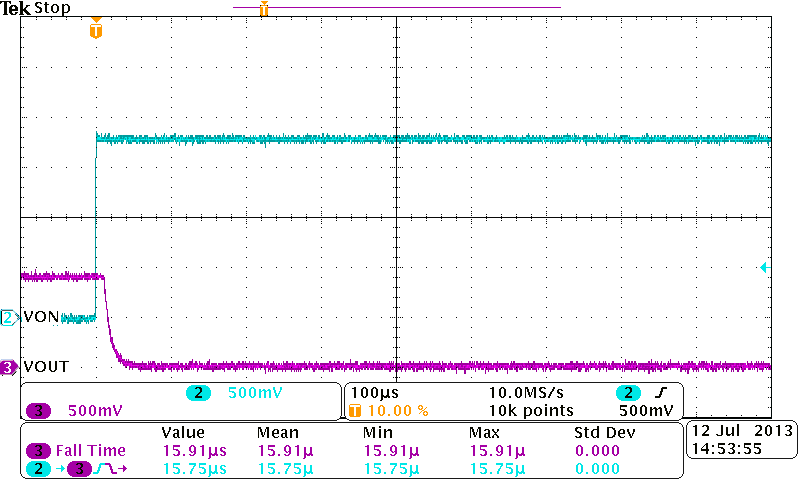
| VIN = 0.9 V | CIN = 10 µF | RL = 10 Ω |
| TA = 25°C | CL = 1 µF |
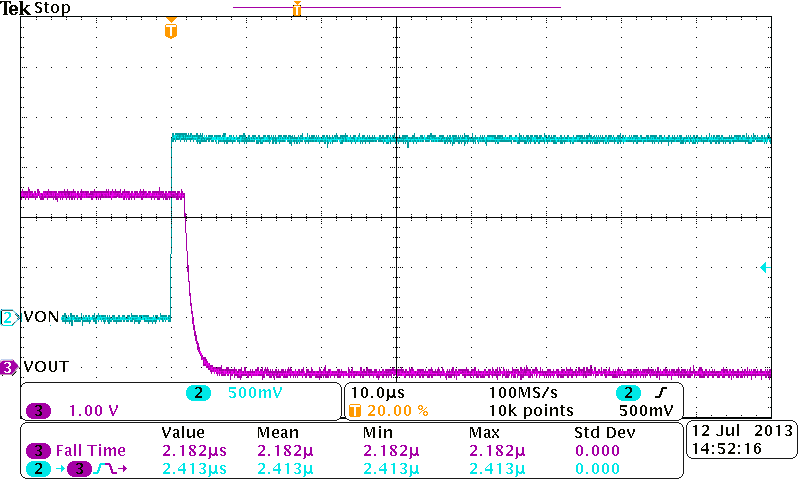
| VIN = 3.6 V | CIN = 1 µF | RL = 10 Ω |
| TA = 25°C | CL = 0.1 µF |
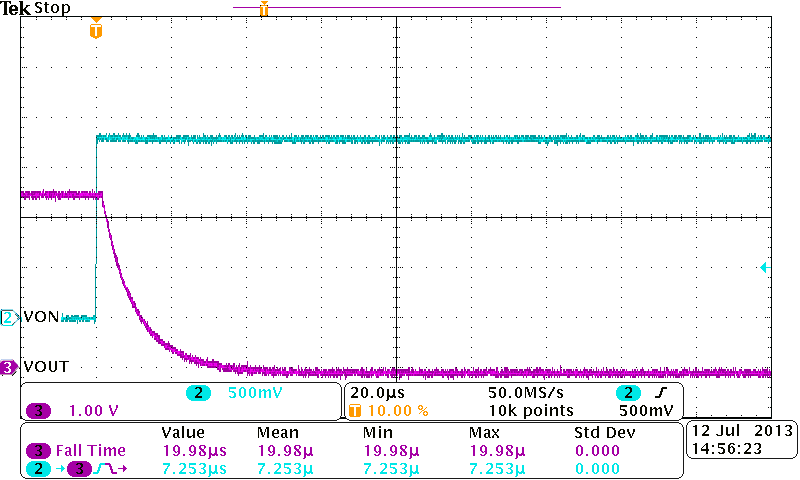
| VIN = 3.6 V | CIN = 10 µF | RL = 10 Ω | ||
| TA = 25°C | CL = 1 µF |
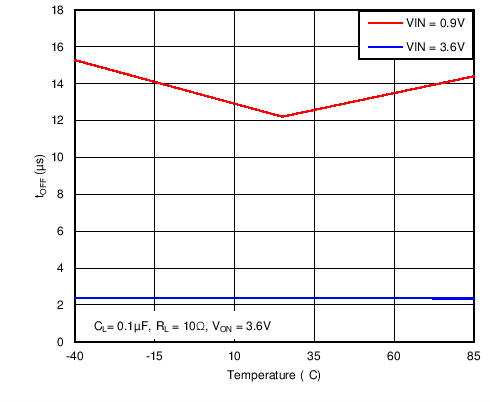
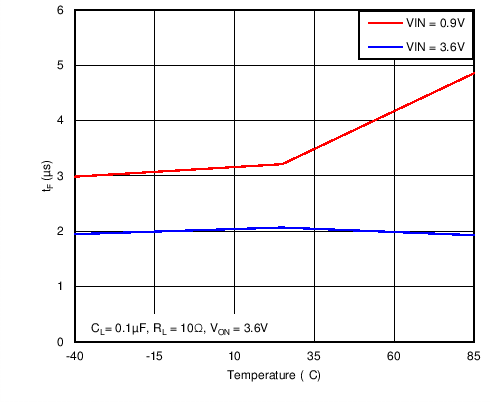
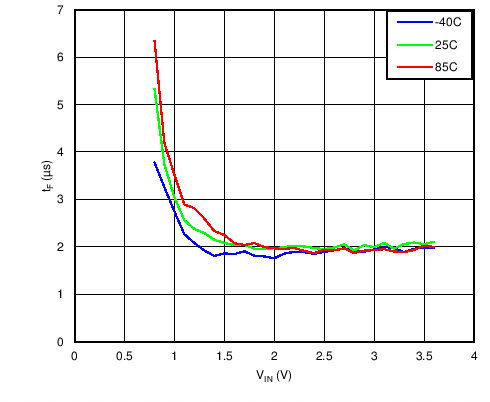
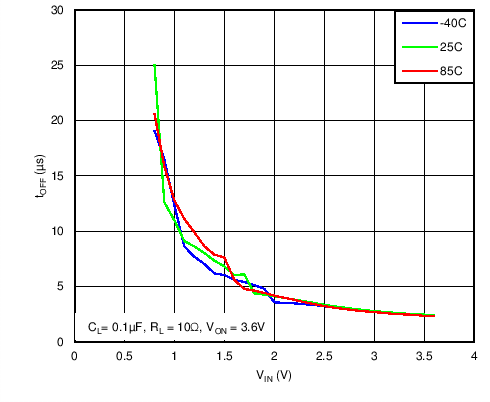
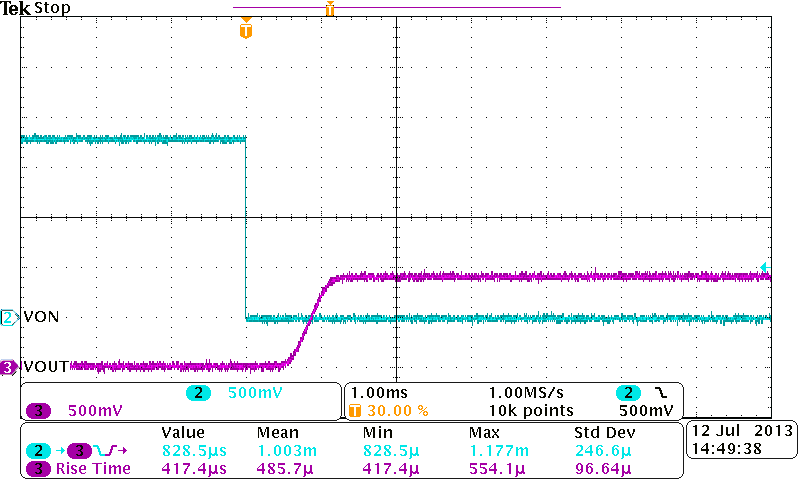
| VIN = 0.9 V | CIN = 1 µF | RL = 10 Ω |
| TA = 25°C | CL = 0.1 µF | |
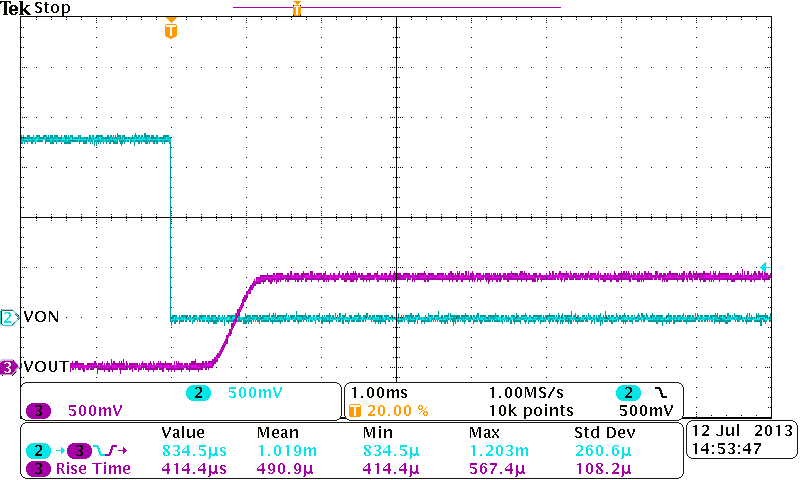
| VIN = 0.9 V | CIN = 10 µF | RL = 10 Ω |
| TA = 25°C | CL = 1 µF |
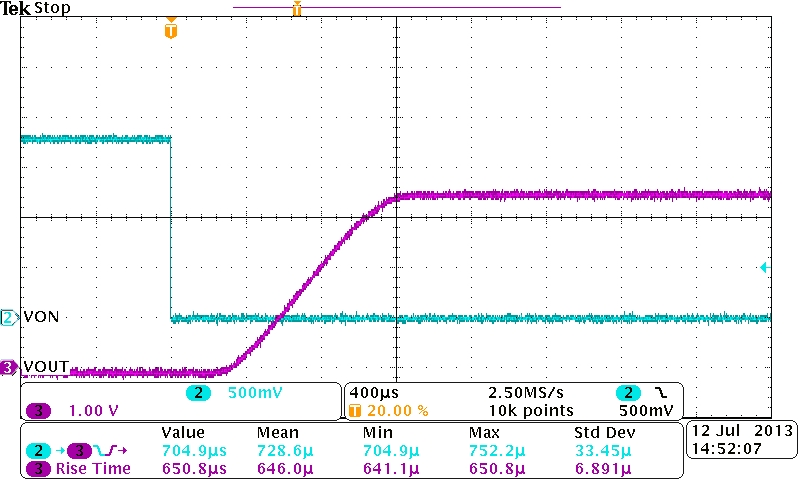
| VIN = 3.6 V | CIN = 1 µF | RL = 10 Ω |
| TA = 25°C | CL = 0.1 µF |
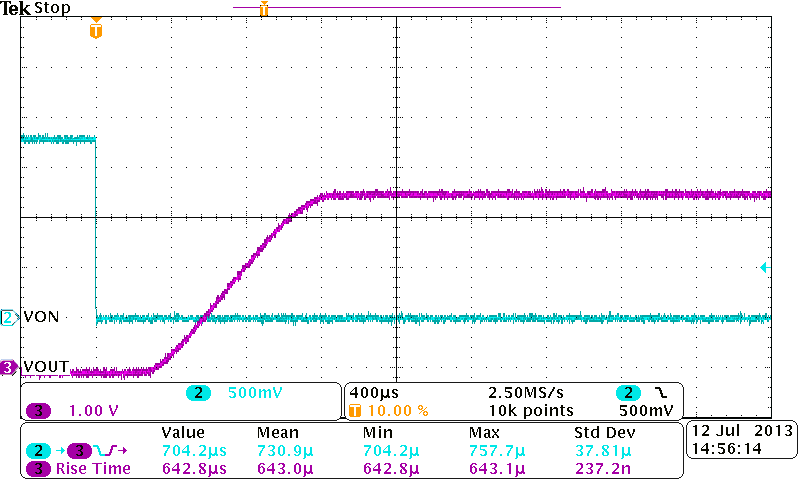
| VIN = 3.6V | CIN = 10 µF | RL = 10 Ω |
| TA = 25°C | CL = 1 µF |
